INTRODUCION
Fresh produce is transported from farm to distribution centres and then to retail shops. It is a general practice that fresh vegetables are washed in water before they are supplied to retailers. After washing, fresh produce commodities are packed and transferred to different shops by different food chains. At any of these steps a careless omission would give Listeria monocytogenes a chance to contaminate fresh vegetables, such as during storage conditions (including temperature, moisture, and oxygen content) and/or sanitation conditions during packing processes and transport. At the end of 2014, a listeriosis outbreak related to caramel apples occurred, which led to 35 people being infected by L. monocytogenes.1 After testing, L. monocytogenes was detected in the apple-packing factory.
Most fresh produce is pre-treated, i.e. by ultraviolet (UV),2 washing3 or chlorine disinfection4 before being sold. However, Listeria spp. and L. monocytogenes were found in fresh produce from retail shops; for example, in pre-packaged mixed vegetable salads,5 parsley6 and lettuces.7
Fresh vegetables are consumed by almost all families. According to a local report,8 in 2013, local consumers spent NZ$ 41.8 million on fresh lettuces and NZ$ 30 million on fresh carrots. New Zealand produced nearly 1.4 million tonnes of vegetables, while 500,000 tonnes were exported and over 900,000 tonnes were consumed locally. Therefore, to understand the safety of fresh produce in retail shops is at least as significant as that in farms. The research described in this article investigated the prevalence of Listeria spp. in selective salad vegetables from different retail shops in the Canterbury region of South Island, New Zealand.
MATERIAL AND METHODS
Sample Collection
Four different retail shops were selected in this study: (1) an open market (Market A); (2) a supermarket (Market B); (3) an Asian grocery store (Market C); and (4) a fruit and vegetable market (Market D). A total of 96 samples were collected from 4 local markets. Lettuce, cabbage, cucumber and carrot samples were collected from these markets over a period of 6 weeks.
Sample Preparation
Fresh produce samples were packaged separately and stored at 5 o C before the analysis. To reduce the influence of objective factors, samples were washed in the same tap water and cut with sterile tools (including knives and cutting boards). All samples were tested for the presence of L. monocytogenes following the procedure recommended by the International Organisation for Standardisation (ISO) procedure.
Listeria spp. Detection and Enumeration
Twenty-five grams of a representative portion from each sample was introduced aseptically into a sterile stomacher bag containing 225 ml of peptone water. Listeria selective agar (CM0856, OXOID) and DifcoTM plate count agar (for aerobic plate counts) were plated the after making suitable dilutions. Following incubation at 35 o C for 24-48 h, the colonies were counted and results were reported in cfu/g. Gram staining and carbohydrate utilization profiles were used to further characterize the Listeria colonies.
The following formula was used to calculate cfu/g:
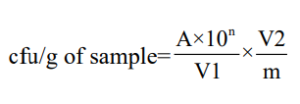
where A – number of colonies (average of the plates);
10n – level of dilution at which the counting was carried out;
V1 – volume of inoculum;
V2 – total volume of peptone water;
m – total sample weight
Statistical Analysis
Statistical analysis was conducted using Minitab Statistical Software version 17 (Minitab Pty Ltd., NSW, Australia). The software functions were used to analyze the experimental data. The Tukey test was used to compare the means. When values differed at p<0.05 level, the results were considered to be as a significantly different.
RESULTS AND DISCUSSION
Comparsion of Microbial Levels by Different Retail Markets
Market A was an open market that operated each Sunday. Four types of vegetable samples were collected over a 6-week period to compare the total microbial counts and the presence of Listeria spp. Data was statistically analysed using the Tukey test. The total microbial populations in the cabbage, carrot and lettuce were not significantly different and the mean counts were around 7 log cfu/g. The cucumber samples had the lowest microbial count (4.5 log cfu/g). The Listeria spp. detected in 4 different types of fresh produce samples were significantly different (p<0.05). The highest population of Listeria spp. was detected in lettuce (4.5 log cfu/g), followed by cucumber (about 3 log cfu/g; mean). The Listeria spp. count was the 2nd lowest load in cabbage (1.5 log cfu/g). The Listeria spp. contamination was lowest in carrot with less than 1 log cfu/g (Figure 1).
Figure 1: Comparative microbial analysis of fresh produce samples from Market A. Error bars represent standard deviations of the means. Different letters on each bar show that the results have significant differences using the Tukey test, p<0.05.
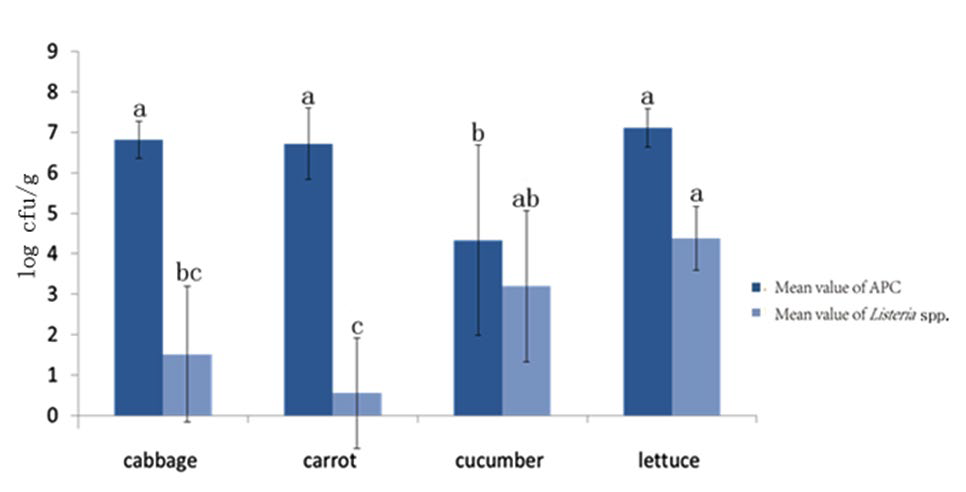
Market B was an outlet from a supermarket chain, which had constant suppliers providing fresh vegetables. Four types of vegetables were sampled over the 6-week collection period. Therefore, it was not suitable to compare the microbial levels and Listeria spp. levels for these 4 types of vegetable samples from Market B. The results were similar to as observed for Market A, where cabbage, carrot and lettuce belonging to the same group were contaminated and a range between 6 to 7 log cfu/g was recorded. In contrast, the APC value of cucumbers was lower (3 log cfu/g). The level of Listeria spp. in lettuce was the highest mean (4 log cfu/g) among the 4 types of vegetables from Market B. The second highest mean population of Listeria spp. was in cabbage (2.5 log cfu/g) followed by cucumber (2 log cfu/g). The population of Listeria spp. in carrot was the lowest (1 log cfu/g) (Figure 2).
Figure 2: Comparative microbial analysis of fresh produce samples from Market B. Error bars represent standard deviations of the means. Different letters on each bar show that the results have significant differences using the Tukey test, p<0.05
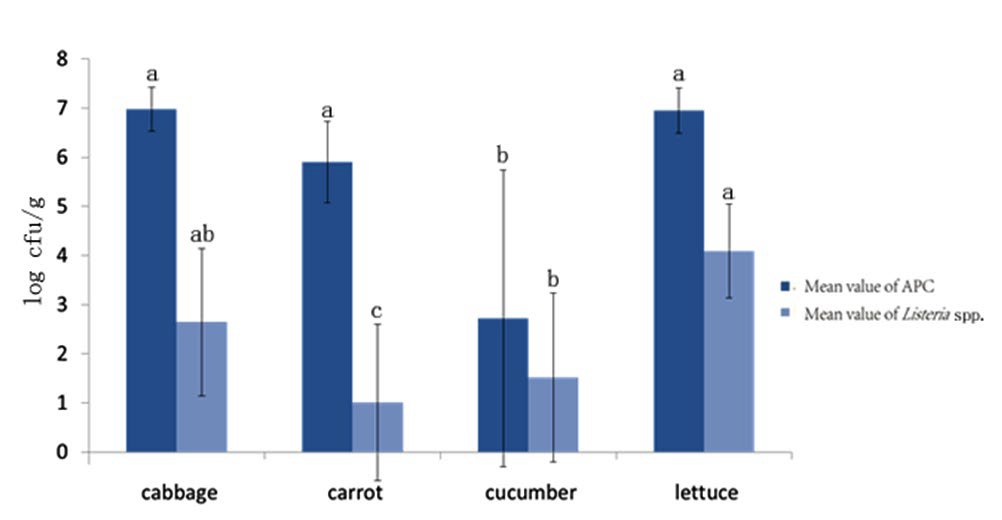
Market C was an ethnic retail shop that sold a variety of commodities, including fresh produce. Four types of vegetable samples were collected over six weeks to test for total microbial counts and the presence of Listeria spp. There were no significant differences (p>0.05) in the total plate counts of the fresh produce samples sold in Market C (Figure 3). The mean APC values of the fresh produce samples in Market C ranged from 5.5 to 7 log cfu/g. Leafy vegetables (cabbage and lettuce) in Market C had similar Listeria spp. contamination levels when analyzed by the Tukey test. However, the Listeria spp. levels in lettuce (4 log cfu/g) were higher compared to those in cabbage (3 log cfu/g), followed by those in cucumber (3 log cfu/g). Carrot contained the lowest of Listeria spp. population (less than 1 log cfu/g) (Figure 3).
Figure 3: Comparative microbial analysis of fresh produce samples from Market C. Error bars represent standard deviations of the means. Different letters on each bar show that results have significant differences using the Tukey test, p<0.05.
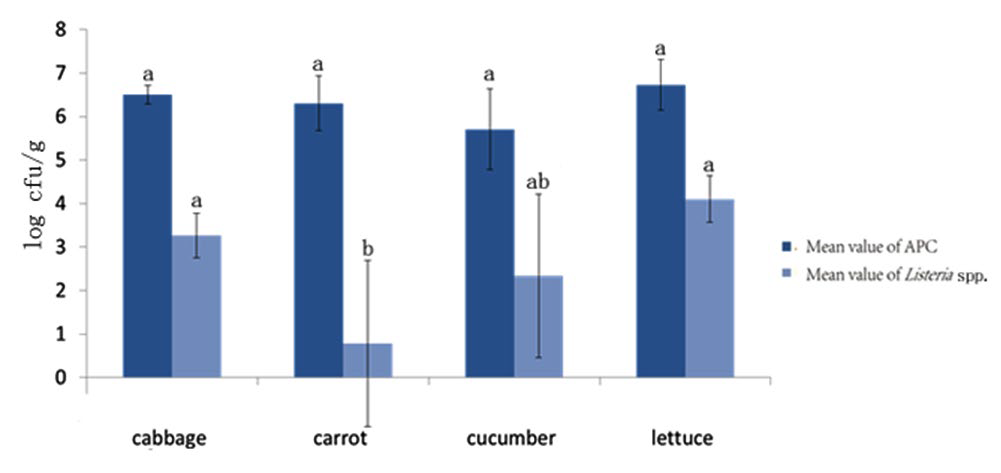
Market D was a fruit and vegetable retail shop outlet where fresh produce was the major commodity sold. Four different types of vegetable samples were collected to evaluate the microbiological quality and the presence of Listeria spp. contamination during 6-weeks of sampling. Statistically significant differences were recorded for total plate counts using the Tukey test. The microbial populations were highest in the cabbage and lettuce samples (7 log cfu/g). The population of total microbes in carrots (6.5 log cfu/g) was slightly lower and significantly different from cabbage and lettuce (7 log cfu/g) (p=0.05). The APC in cucumber were lowest in the samples from Market D (fewer than 5 log cfu/g). In contrast, the levels of Listeria spp. in the cabbage and lettuce were higher than in other types of vegetables. No Listeria spp. were detected in carrot samples from Market D (Figure 4).
Figure 4: Comparative microbial analysis of fresh produce samples from Market D. Error bars represent standard deviations of the means. Different letters on each bar show that results have significant differences using the Tukey test, p<0.05
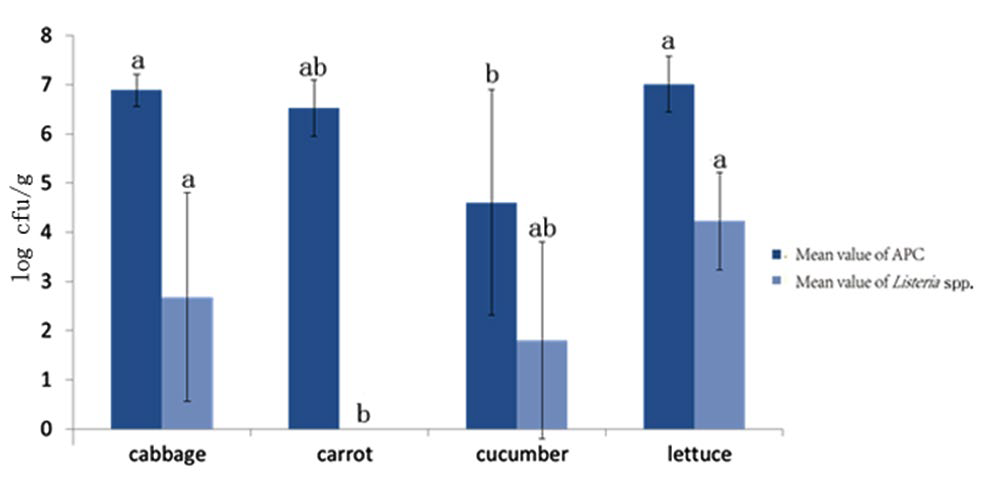
Comparsion of Microbial Levels by Fresh Produce Type
The microbial quality (Listeria spp. and APC) of fresh produce was compared between four retail shops. Statistical analysis (Tukey test) of the microbial analyses showed that, the fresh produce samples were not significantly different (p>0.05) among the retail shops selected (Figure 5). The mean Listeria spp. levels in the cabbage samples ranged from 1.5 to 3 log cfu/g (whereas APC values were about 7 log cfu/g). Listeria spp. levels in the carrot samples ranged from 0 to 1 log cfu/g and APC values ranged from 6 to 7 log cfu/g. Listeria spp. levels in the cucumber samples ranged from 1.5 to 3.5 log cfu/g (APC levels ranged from 2.5 to 6 log cfu/g). For lettuce samples, Listeria spp. levels were about 4 log cfu/g (and APC levels were about 7 log cfu/g)
Figure 5: Comparative microbial analysis of fresh produce samples from Market A to D. (A) cabbage (B) carrot (C) cucumber (D) lettuce. Error bars represent standard deviations of the means. Different letters on each bar show that results have significant differences using the Tukey test, p>0.05.
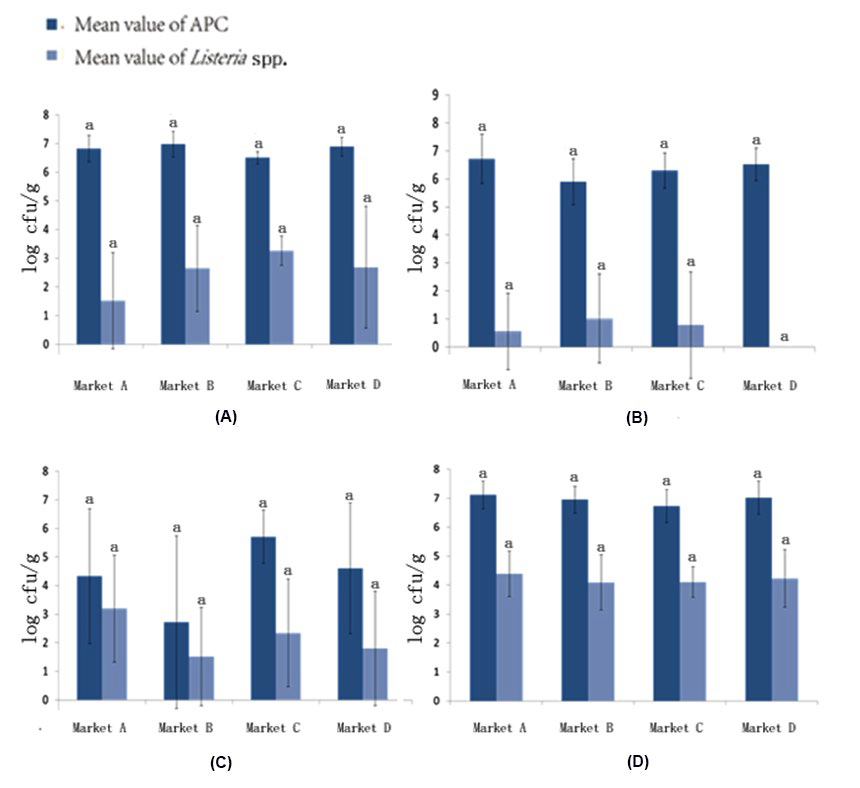
Overview of Listeria spp. in Fresh Produce Samples from Retail Shops
In general, the average APC values were similar for cabbage, carrot and lettuce samples collected from the four retail shops (Figure 6A). Similarly the samples from the farms, the APC values were between 6 to 7 log cfu/g. The mean APC of the carrot samples from Market B had the lowest value, which was fewer than 6 log cfu/g. On average, lettuce samples from Market A and Market D had comparatively higher APC (>7 log cfu/g). The cucumber samples had the lowest microbial load, ranging from 2.72 to 5.68 log cfu/g. However, a research report on the microbiological analysis of salad vegetables in markets in India9 reported an average APC of 9 log cfu/g. The Listeria spp. counts for fresh produce from retail shops are presented in Figure 6B. The majority of APC values in cabbage and cucumber were distinguished in the same group using the Tukey test. Carrot samples had the lowest Listeria spp. load (<1.05 log cfu/g) and lettuce samples had the highest Listeria spp. load (4 log cfu/g). There were no significant differences in the same type of fresh produce among the four retail shops. Other research from Dhaka, which evaluated the prevalence of bacteria in salad vegetables,10 reported much higher Listeria spp. load (6 to 8 log
cfu/g) than the results of this study.
Figure 6: Comparative microbial analysis of samples from four retail shops. A, APC and B, Listeria spp. Error bars represent standard deviations of the means. Different letters on each bar show that results have significant differences using the Tukey test, p<0.05.
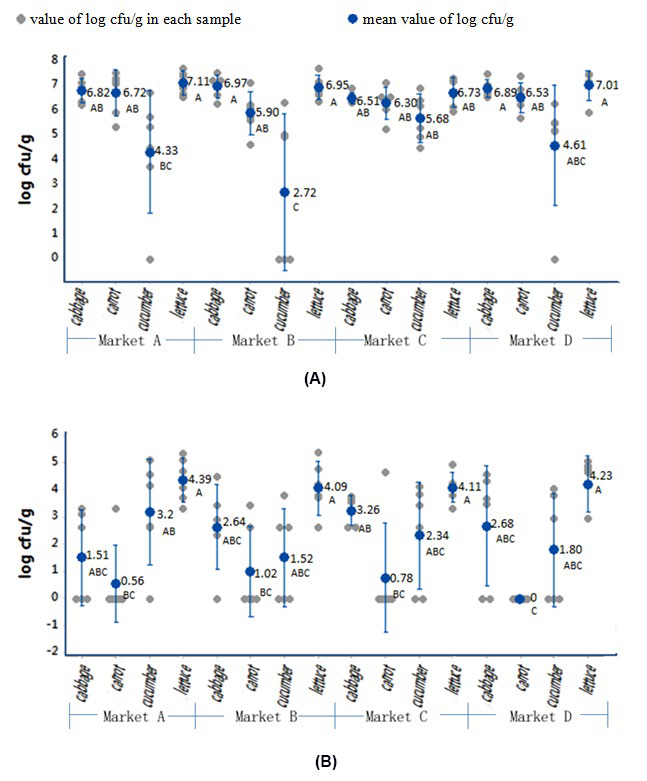
DISCUSSION
The results of this study mainly compared the microbial populations and presence of Listeria spp. in selected vegetables from four retail shops in the Canterbury region. Each type of vegetable purchased from the selected shops did not show significant differences in microbial quality (APC). However, slight differences inwere observed (Figures 5 and 6). For cabbage samples, the highest Listeria spp. Loads were in samples from the Market C, with a mean of 3.26 log cfu/g, while the lowest population of Listeria spp. were detected in the samples from Market A, with a mean of 1.51 log cfu/g. Carrot samples had the lowest Listeria spp. load. Among four types of fresh produce from 4 retail shops, the highest loads were in Market B (1.02 log cfu/g) and all samples from Market D showed negative results. The population of Listeria spp. in cucumber was similar to that in cabbage, with the highest value of Listeria spp. load in Market A (3.2 log cfu/g) and the lowest value of Listeria spp. load in Market B (1.52 log cfu/g). The lettuce samples had the highest bacterial load among the 4 types of vegetables with the highest APC values and Listeria spp. levels. Lettuce samples from Market A (4.39 log cfu/g) had the highest population of Listeria spp. compared to the lowest Listeria spp. in the samples from Market B (4.09 log cfu/g).
In the assessment of L. monocytogenes associated with lettuce, L .monocytogenes was positive in 5 RTE lettuce samples.7 All colonies isolated belonged to serotype 1/2a. In another research on a risk assessment for L. monocytogenes from the farm to the table in Korea,11 the mean final L. monocytogenes contamination levels reported were -1.50 log cfu/g and -0.146 log cfu/g at restaurants and in homes, respectively. In the bacteriological assessment of fresh produce in Norway,12 just one in 200 lettuce samples was positive for L. monocytogenes. In the study on the detection of Listeria spp. in RTE products in Malysia,13 Listera spp. were found in 20% of salad and vegetable samples, including 2 lettuce samples, 2 cucumber samples, 1 tomato sample and 3 cabbage samples. L. monocytogenes was positive in 1 lettuce sample, 2 cucumber samples and 2 cabbage samples. In the microbial evaluation for minimally-processed vegetables, just one in 112 sprouts samples was positive for L. monocytogenes, and lettuce and other fruit and vegetable samples were negative for this bacterium.14 In another microbial assessment of fresh produce, L. monocytgenes was found in 3.4% of lettuce samples (≤2 log cfu/g).15The prevalence of pathogens in fresh produce reported by Rahman and Noor,10 the population of Listeria spp. on fresh produce (cucumber, carrot, lettuce) ranged from 6 log cfu/g to 8 log cfu/g, which was much higher than results reported here. In a previous study, Listeria spp. were commonly detected in cabbage and lettuce samples.16
Sample collection from retail shops did not seem to be influenced by seasonal changes. Therefore, all fresh produce from retail shops were collected over 6-weeks. Microbial quality may be influenced by storage conditions, including temperature, relative humidity (RH), O2 and CO2 contents, storage time and surfaces touched.
A group of scientists completed research on the effect of storage temperature and RH on the growth of L. monocytogenes. 17 They examined lettuce leaves, parsley leaves and cucumber epidermis samples at 3 temperatures and at two RH values. L. monocytogenes was detected in the cucumber epidermis samples. The results showed that L. monocytogenes preferred higher temperature and RH. In addition, L. monocytogenes had difficultly surviving on intact vegetable surfaces.17
Francis et al18 studied the effect of atmosphere and acid adaptation on growth of L. monocytogenes using intact lettuce leaves to prepare lettuce agar to monitor the growth of L. monocytogenes. Lettuce agar plates with L. monocytogenes were stored separately under 3 conditions (a. air; b. 10% CO2 , 5% O2 , 85% N2 ; and c. 25% CO2 , 75% N2 ) at 8 o C. Microbial levels were tested over the storage period. The results showed that the vitality of the Listeria spp. was improved when samples were stored under 25% CO2 conditions, and the most optimal condition for vegetable packing was in a 5 to 10% CO2 content atmosphere.18
In addition, in a research report on storage temperatures, L. monocytogenes growth in fresh produce at 7 °C and 15 °C for 6 days was compared.19 The result showed that the population of L. monocyogenes increased more at 15 °C over the storage period. Similar findings have been reported on the effect of storage conditions on L. monocytogenes growth at 3 different temperatures (4 °C, 12 °C and 22 °C) for comparison.20 L. monocytogenes survived better at higher temperatures with an increase in cell count of 0.3 log cfu/g in the first 17 h of storage.
CONCLUSIONS
The results of this study showed that cabbage and lettuce had similar levels of total microbial loads. However, the contamination of Listeria spp. in lettuce was higher than in cabbage. The total microbial load in carrot samples was higher in the cucumber samples while the prevalence of Listeria spp. was higher in the cucumber samples. Overall, all 4 different types of vegetable samples had similar microbiological quality regardless of the market source. However, some variations were observed in the samples when analyzed on a weekly basis. L. monocytogenes was not detected in the fresh produce samples tested. However, ongoing risk assessment activities are required to ensure fresh produce safety.
CONFLICTS OF INTEREST
The authors declare that they have no conflicts of interest.












